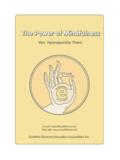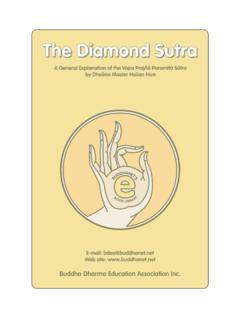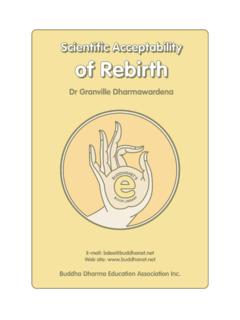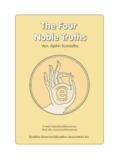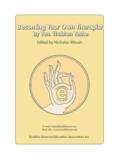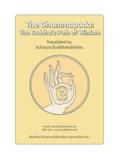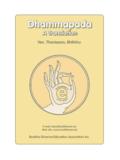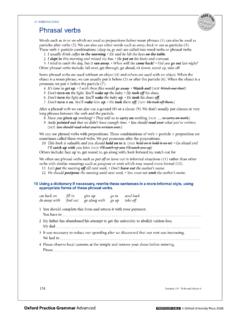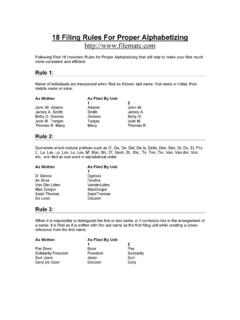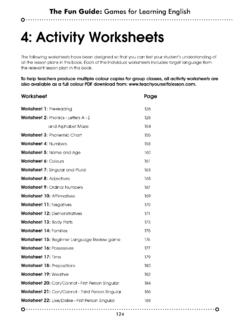Transcription of A Practical grammar of the pali language - Buddhism
1 EBUDDHANET'SBOOKLIBRARYE-mail: site: Dharma Education Association Charles DuroisellePractical grammar of the pali LanguagePractical grammar of the pali LanguageA Practical Grammarof theP li Languageby Charles DuroiselleThird Edition 1997 Appendix 1 Here is a collection of dictionary definitions of some of the terms that can be found in this bookAblative: Of, relating to, or being a grammatical case indicating separation, direction away from,sometimes manner or agency, and the object of certain verbs. It is found in Latin and other Indo-European absolute: In Latin grammar , an adverbial phrase syntactically independent from therest of the sentence and containing a noun plus a participle, an adjective, or a noun, both in theablative : Of, relating to, or being the case of a noun, pronoun, adjective, or participle that isthe direct object of a verb or the object of certain : Indicating that the subject of the sentence is performing or causing the action expressedby the verb.
2 Used of a verb form or : Any of a class of words used to modify a noun or other substantive by limiting,qualifying, or specifying and distinguished in English morphologically by one of several suffixes,such as -able, -ous, -er, and -est, or syntactically by position directly preceding a noun or nominalphrase, such as white in a white : A form of a verb in some languages, such as Classical Greek or Sanskrit, that in theindicative mood expresses past : To inflect (a verb) in its forms for distinctions such as number, person, voice, mood,and : Of, relating to, or being the grammatical case that in some Indo-European languages,such as Latin and Russian, as well as in some non-Indo-European languages, marks the recipientof action and is used with prepositions or other function words corresponding in meaning toEnglish to and : Linguistics. a. In certain languages, the inflection of nouns, pronouns, and adjec-tives in categories such as case, number, and : Of, relating to, or designating a case that expresses possession, measurement, : A verbal noun analogous to the Latin gerund, such as the English form ending in -ingwhen used as a noun, as in singing in We admired the choir s : The system of inflections, syntax, and word formation of a : a.
3 An alternation of the form of a word by adding affixes, as in English dogs fromdog, or by changing the form of a base, as in English spoke from speak, that indicates grammati-cal features such as number, person, mood, or tense. b. The paradigm of a word. c. A pattern offorming paradigms, such as noun inflection or verb : Of, relating to, or being an element or construction used to ask a question: aninterrogative adverb; an interrogative : Of, relating to, or being a grammatical case in certain inflected languages that indi-cates place in or on which or time at which, as in Latin dom , 'at home.'Nominative: Of, relating to, or belonging to a case of the subject of a finite verb (as I in I wrotethe letter) and of words identified with the subject of a copula, such as a predicate nominative (aschildren in These are his children).Optative: Of, relating to, or being a mood of verbs in some languages, such as Greek, used toexpress a wish.
4 Designating a statement using a verb in the subjunctive mood to indicate a wishor desire, as in Had I the means, I would do Participle: A participle expressing present action, formed in English by the infinitiveplus -ing and used to express present action in relation to the time indicated by the finite verb inits clause, to form progressive tenses with the auxiliary be, and to function as a verbal : Of, relating to, or being a verb form or voice used to indicate that the grammaticalsubject is the object of the action or the effect of the verb. For example, in the sentence Theywere impressed by his manner, were impressed is in the passive : A form of a verb that in some languages, such as English, can function independentlyas an adjective, as the past participle baked in We had some baked beans, and is used with anauxiliary verb to indicate tense, aspect, or voice, as the past participle baked in the passivesentence The beans were baked too Participle: A verb form indicating past or completed action or time that is used as a verbaladjective in phrases such as baked beans and finished work and with auxiliaries to form thepassive voice or perfect and pluperfect tenses in constructions such as She had baked the beansand The work was finished.
5 Also called perfect : An affix, such as dis- in disbelieve, put before a word to produce a derivative word or aninflected : Of, relating to, or functioning as a pronoun. Resembling a pronoun, as by specify-ing a person, place, or thing, while functioning primarily as another part of speech. His in hischoice is a pronominal : Arising from or going to a root or source; basic: a radical flaw in a plan; chose theradical solution of starting all over : designating or expressing a grammatical relation in which a verb s subject and anobject in the sentence refer to the same person or thing, serving to indicate that the action of theverb is directed back to the subject Ex. Gary hurt himself , Jane threw a party for herself .Sanskrit: An ancient Indic language that is the language of Hinduism and the Vedas and is theclassical literary language of : 1. Expressing or designating existence; for example, the verb to be.
6 2. Designatinga noun or noun : An affix added to the end of a word or stem, serving to form a new word or functioningas an inflectional ending, such as -ness in gentleness, -ing in walking, or -s in : Relating to or being a grammatical case used in Latin and certain other languages toindicate the person or thing being Adjective: An adjective that is derived from a verb and that in some constructions, parti-cipial phrases for example, preserves the verb's syntactic features, such as transitivity and thecapability of taking nominal or verbal complements. Font name Norman Printer Driver 1234567891011121314151617181920212223242 5262728293031323334353637383940414243444 5-------------------------------!"#$%&'( )*+, :;<=>?@ABCDEFGHIJKLMNOPQRSTUVWXYZ919293949596 9798991001011021031041051061071081091101 1111211311411511611711811912012112212312 4125126127128129130131132133134135[\]^_` abcdefghijklmnopqrstuvwxyz{|}~ 1361371381391401411421431441451461471481 4915015115215315415515615715815916016116 2163164165166167168169170171172173174175 176177178179180 1811821831841851861871881891901911921931 9419519619719819920020120220320420520620 7208209210211212213214215216217218219220 221222223224225.
7 Fifl 2262272282292302312322332342352362372382 3924024124224324424524624724824925025125 2253254255 CS+=C+=CS+[CS+]C+[C+]CS+8CS+6 CommonKeyboardShortcutsC=ControlS=ShiftC ONTENTS(The numbers within bracket refer to the paragraphs).PREFACECHAPTER I THE ALPHABET .. short and long (2-5)The letters classified (6)Pronunciation (10-11)Conjunct consonants (12-13)CHAPTER II SANDHI (14-16)Vowel sandhi (17-27)Consonantal Insertions (28)Consonantal sandhi (29-36)Niggah ta Sandhi (37-46)Interchange of letters (47)Signs (48- 50)CHAPTER III (51-52)Kinds of Assimilation (53)General Rules (54- 66)Assimilation of Nasals (67-69)Assimilation Of y (70-79)Assimilation of r (80-84)Assimilation of s (85-95)Assimilation of h (96-102)CHAPTER IV V DECLENSION OF NOMINAL or Base (116, b)Gender (116, c, d)The Cases (116, f)Divisions of Declension (117)General case endings (118)Vowel declension, stems in a (119-121)Masculines in a, deva (122)Neuters in a, r pa (123-124)Declension of nouns in (125)Feminines in ka (126-127)Masculines in , s (128)
8 Declension of nouns in i, (129)Masculines in i, kapi (l30-13l)Feminines in i, ratti (132-133)Neuters in i, v ri (134)Declension of nouns in (135)Masculines in , da (136-137) Feminines in nad (138-139)Declension of nouns in u. (140)Masculines in u, bhikkhu (l4l)Feminines in u. dhenu (142-143) Neuters in u, cakkhu (l44-145)Declension of nouns in (146)Masculines in , sayambhu (147)Feminines in , vadh (148)Diphthongal stems (149)Special nouns, go, sakh (150 -151) Consonantal Declension (152)att (154)brahm (155)r j (156)pum (157)Stems in s, mano (159-160) yu (161)Stems in r, satth (163)mat , pit (164)Stems in at, vat, mat, bhava (166) araha (167)iCHAPTER VI FORMATION OF FEMININE Suffixes (181)Feminine bases of substantives (182-192)Feminine bases of adjectives (193-195)CHAPTER VII in a (197-201) Adjectives in (202-204)Adjectives in i (205-210) Adjectives in u (211-214)Adjectives In (215-218) Adjectives with consonantal bases (220-224)mah (226) dh m (228)gu av (230) Adjectives in vi (231-235)
9 Negative Adjectives (236- 237) Comparison (238-247)Irregular Adjectives (247)CHAPTER VIII P. 61 Table of Cardinals and Ordinals (251)Cardinals (252-272)Ordinals (273 -278)Adverbial Derivatives from numerals (279-287)CHAPTER P. 68 PRONOUNS, PRONOMINAL ADJECTIVES AND PRONOMINAL DERIVATIVESP ersonal (288-296)Demonstratives (297-311)Relatives (312-314)Interrogative (315-318)Indefinite (319-327)Other pronouns (328-335)Pronominal derivatives (336-352) Adjectives declined pronominally (353)CHAPTER X P. 80 Introductery (354-369)Primitive Verbs (369)First Conjugation (370-371)Rules of reduplication (372)Second Conjugation (373)Third Conjugation (374-375)Fourth Conjugation (376)Fifth Conjugation (377)Sixth Conjugation (378)Seventh Conjugation (379)Conjugation of the Present System (381-403)Irregular verbs (404)Aorist (405- 426)System of the Perfect (427- 430)Future System (431-438)Participles : Present (439-448)Future ((449) (450-464) (465) (466-469)Gerund (470-472)Infinitive (473-477)Passive Voice (481-490)Causative Verbs (491-497)Denominative Verbs (498-502)Desiderative Verbs (503-507)Intensive Verbs (508-509)Defective anomolous verbs (510-513)Verbal prefixes (514-522)Paradigm of a Verb fully conjugated: pacati (523).)
10 Coreti (524-527)Table of the changes occurring in the root (528)iiCHAPTER XI Adverbs (531)Case-form Adverbs (532)Pure Adverbs (532)Prepositions (533-537)Conjunctions (538)CHAPTER XII (539-541)dvanda (542 -544)tappurisa (545)kammadh raya (546)Nouns in apposition (547)digu (548)Adverbial Compounds (549)Relative Compounds (550-551)Upapada Compounds (552)Anomalous Compounds (553)Complex Compounds (554)Changes in certain words in Compounds (555)Verbal Compounds (556-557)CHAPTER XIII (558-574)Primary derivatives, kita (575-578)Secondary derivation, taddhita (579-581) kvi suffixes (582-584)CHAPTER XIV raka(587)Order of Sentences (588)Article (589)Concord (590-592)Nominative (594)Genitive (595)Dative (597)Accusative (598)Instrumentive (599)Ablative (600)Locative (601)Vocative (602)Genitive and Locative Absolute (603)of Adjectives (604)of Pronouns (605-609)Repetition (610)of Verbs (611-618)of Participles (619-622)of Indeclinables (623)Direct and Indirect Narration (624)Interrogation and Negation (625)CHAPTER XV (626-627)Feet (628-629)Short and long syllables (630)Varieties of Metres (631)sama class (632)addhasama class (634)visama class (635)vatta (636)Kinds of vatta (638)j ti (639-641)vet liya (642)iii1 PREFACE TO THE THIRD EDITIONMost introductory P li grammar books consist of lessons that teach the elements of the language in stages,but because of that they are also very difficult to use as a reference when you need to look up a noun'sdeclension, or a verb's conjugation.
